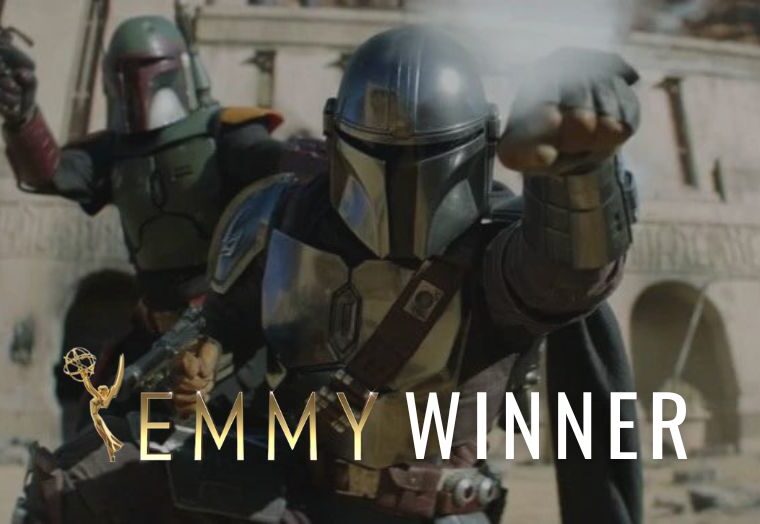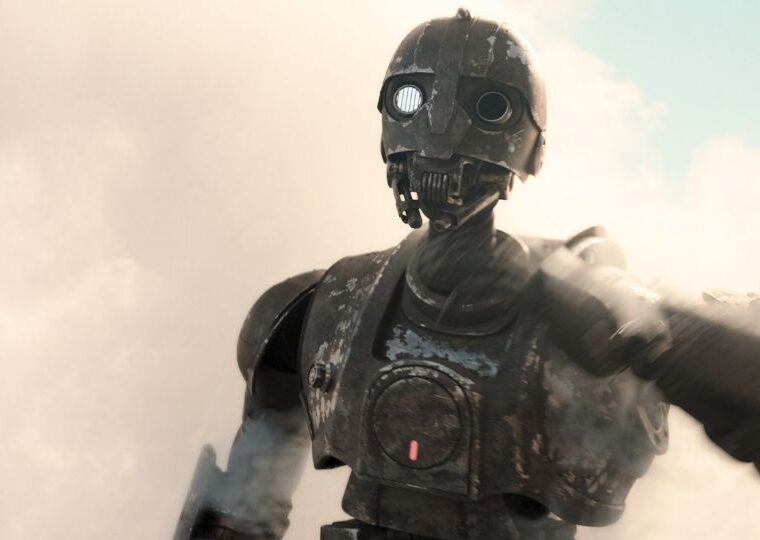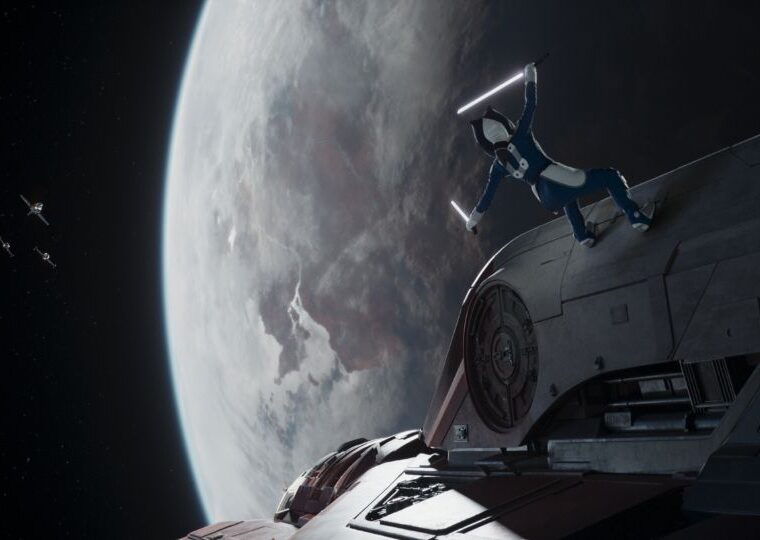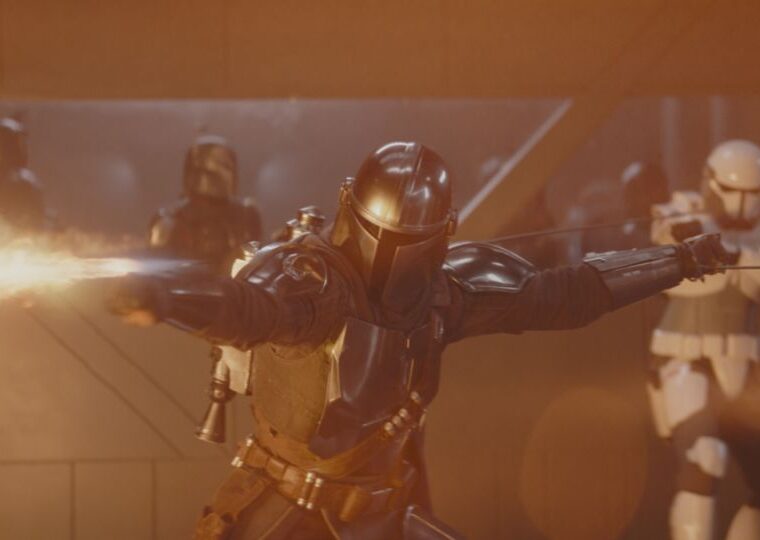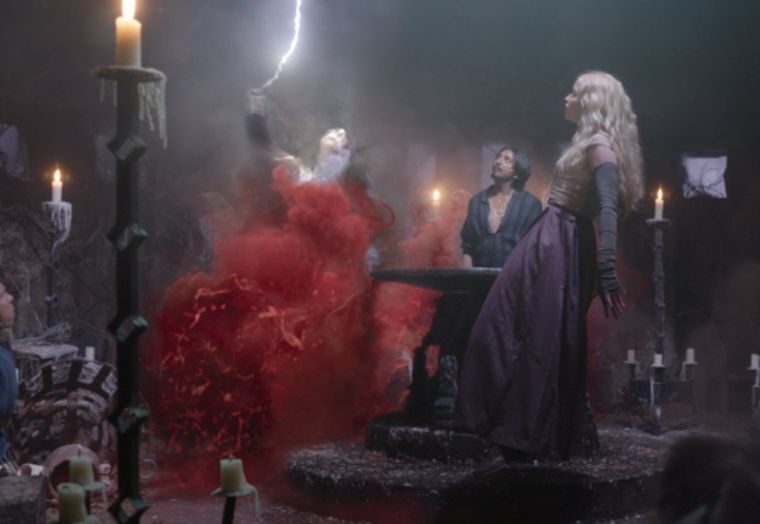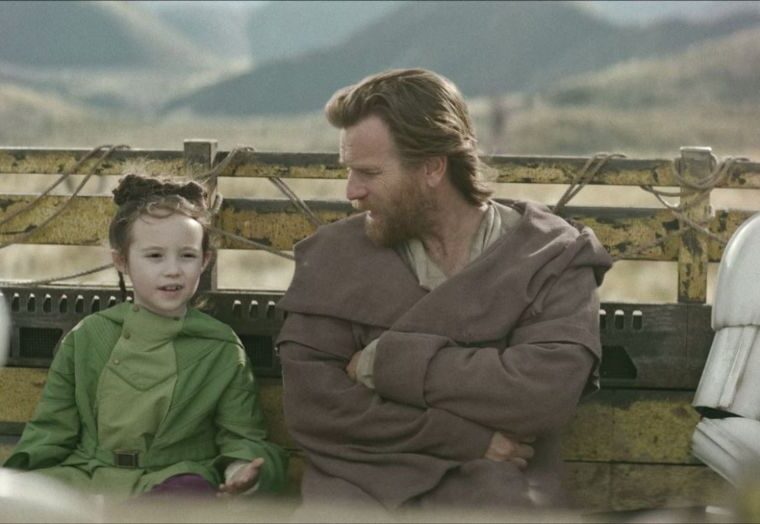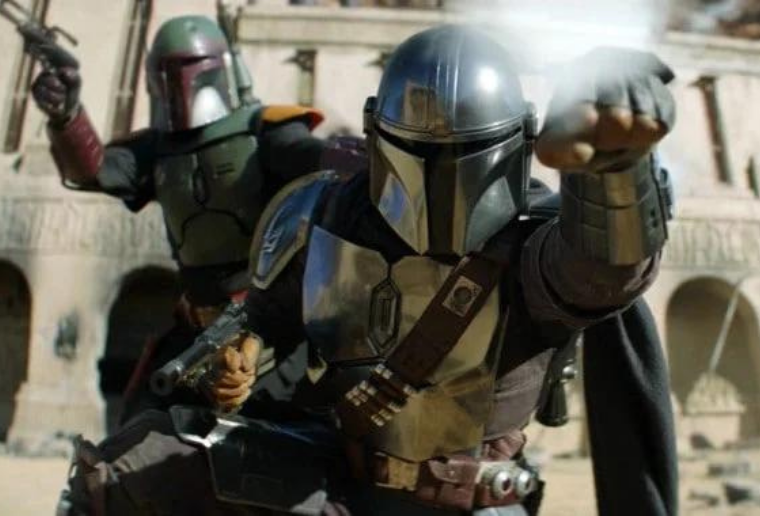The Book of Boba Fett Case Study
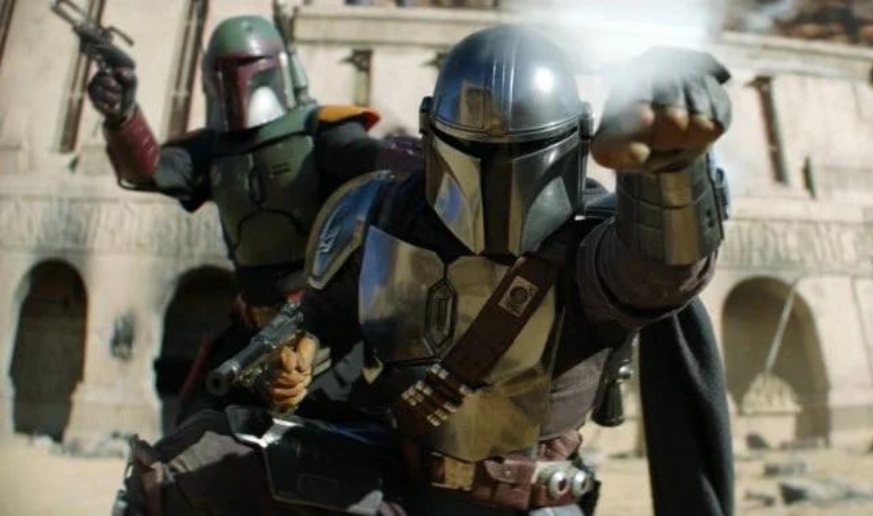
Case Study
Well-versed in the planets, creatures, and droids of Star Wars, Image Engine jumped into the fray to create Tatooine sand cities, jetpack-powered shootouts, and indomitable Scorpenek droids—all while working through a pandemic.
View portfolio page Watch breakdown reelEmmy Award Winner for ‘The Book of Boba Fett’
Image Engine is extremely proud to have won a 2022 Emmy Award for ‘Outstanding Special Visual Effects In A Season Or A Movie’ for The Book of Boba Fett.
Image Engine returned to a galaxy far, far away for a third time, following the show’s predecessor, The Mandalorian seasons 1 and 2 to work on The Book of Boba Fett.
In one of the most exciting sequences in a show packed full of them, The Mandalorian’s second season reintroduced fans to much-loved Star Wars character, Boba Fett. On the Jedi planet of Tython, the Mandalorian Din Djarin is pinned down by Stormtrooper fire. Then, just as things become grievous, Boba Fett appears in full Mandalorian dress and proceeds to dispatch the attacking troopers in brutal swings of gaffi stick and rocket fire. It’s a brilliant revival of a revered character—and a sequence Image Engine helped to create, no less.
Two questions stood out: how did Boba Fett escape from the guts of Return of the Jedi’s Sarlaac, and what did he go on to do next? Over seven episodes, Jon Favreau’s The Book of Boba Fett answers just that. Image Engine was called back to help tell Boba’s story in both the season pilot and its explosive finale, as the bounty hunter fights to take over the territory once controlled by Jabba the Hutt.
Watch our breakdown reel
Assassins attack
Having worked on both season one and two of The Mandalorian, Image Engine was well acquainted with the Star Wars aesthetic and were ready to jetpack into action. “We’ve worked with the same group of people on the production side and built a relationship and trust with them,” begins Robin Hackl, VFX Supervisor. “We know Lucasfilm’s preferences and their expectations, so at this stage, they trust us to run with the sequences we’re given.”
Sequences like the assassin attack in The Book of Boba Fett episode one. Boba Fett and his companion Fennec Shand are patrolling the streets of Mos Espa when a group of shadowy assassins surround the pair with crimson-glowing energy shields and electrified spears. Boba and Fennec must battle their way out of the trap using hand-to-hand combat and explosive ordinance.
“To develop the energy shields’ look, we utilized references from previous Star Wars movies and episodes,” explains Robin. “We then generated the effect in compositing, rather than the more traditional approach of look dev through lighting and rendering, as the comp-centric approach allowed us to iterate and adapt more quickly to the production’s feedback.
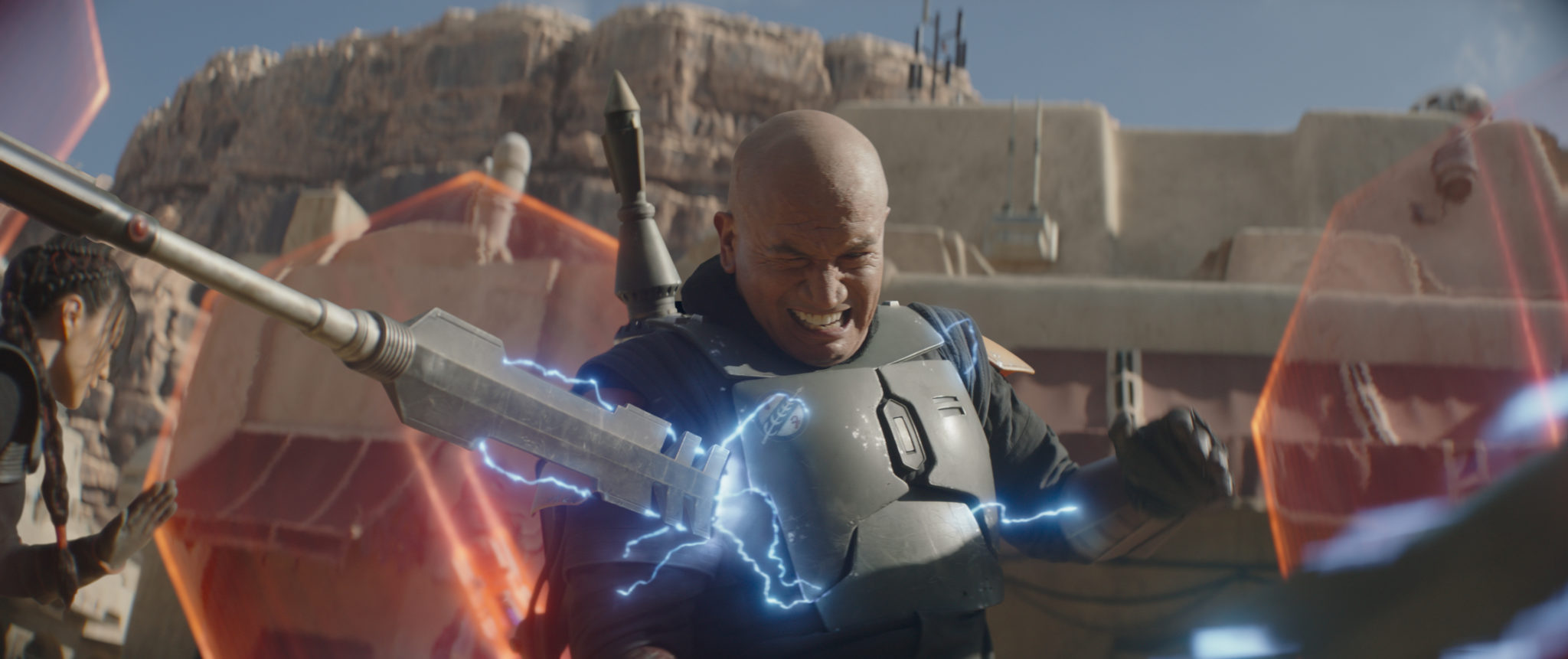
“Next, we made sure the shields looked like they were interacting with each other and the actors,” he continues. “For starters, we had to make sure it looked painful when Boba got poked by a spear or touched a shield. We then had to consider the layering of it all: there were a lot of overlapping people and items, like shields in the foreground, someone behind one shield, and another shield behind that, all of which we needed to cut out and put on cards and push into the pipeline for layout and rendering. It was one of those scenarios with many layers; it was ultimately a very complex rendering.”
“Bringing the sequence together was like a technical logistics operation,” adds Edmond Engelbrecht, CG Supervisor. “From comp to animation and layout, we all had to put our heads together and consider how to visualize the shields, where they would be in the scene, how big they were, how they would be animated, and so on. Once we put in the groundwork and knew exactly how we wanted to approach every element, the fight sequence came together like a pipeline.”


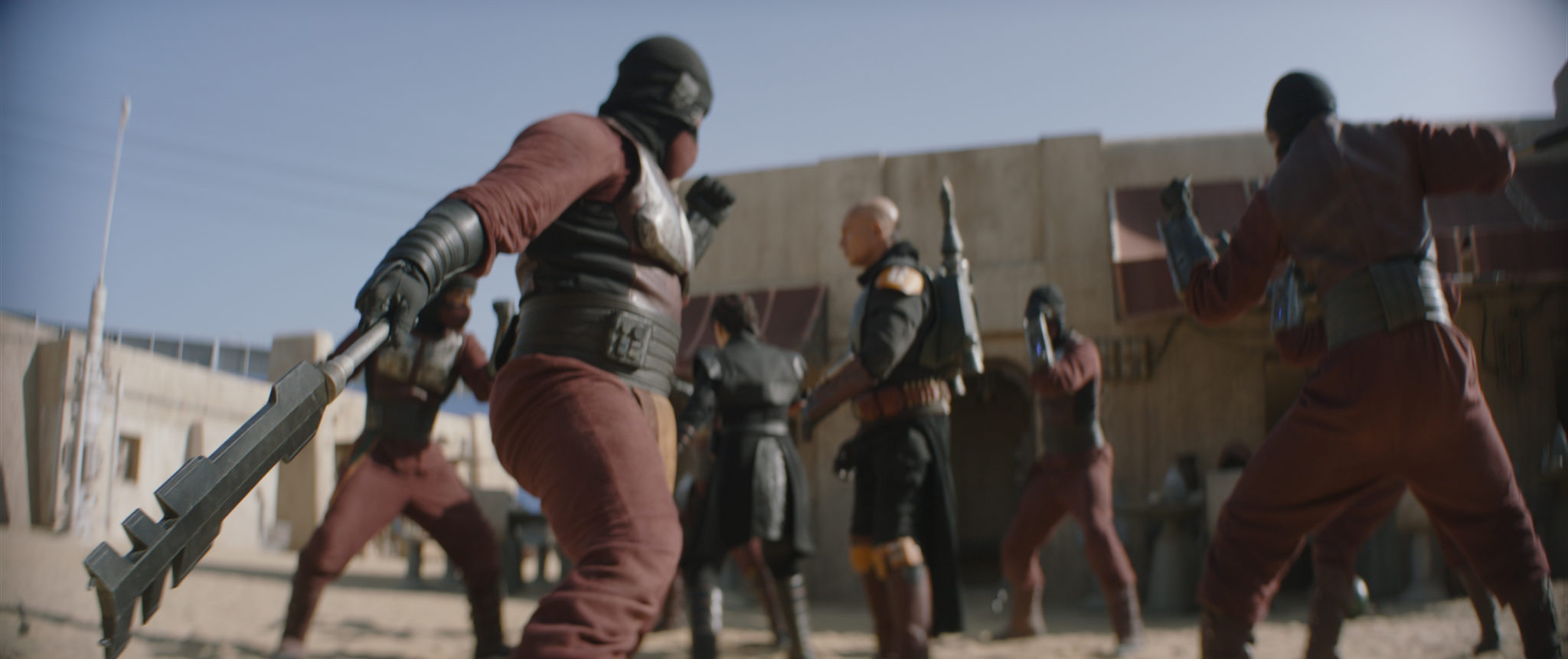
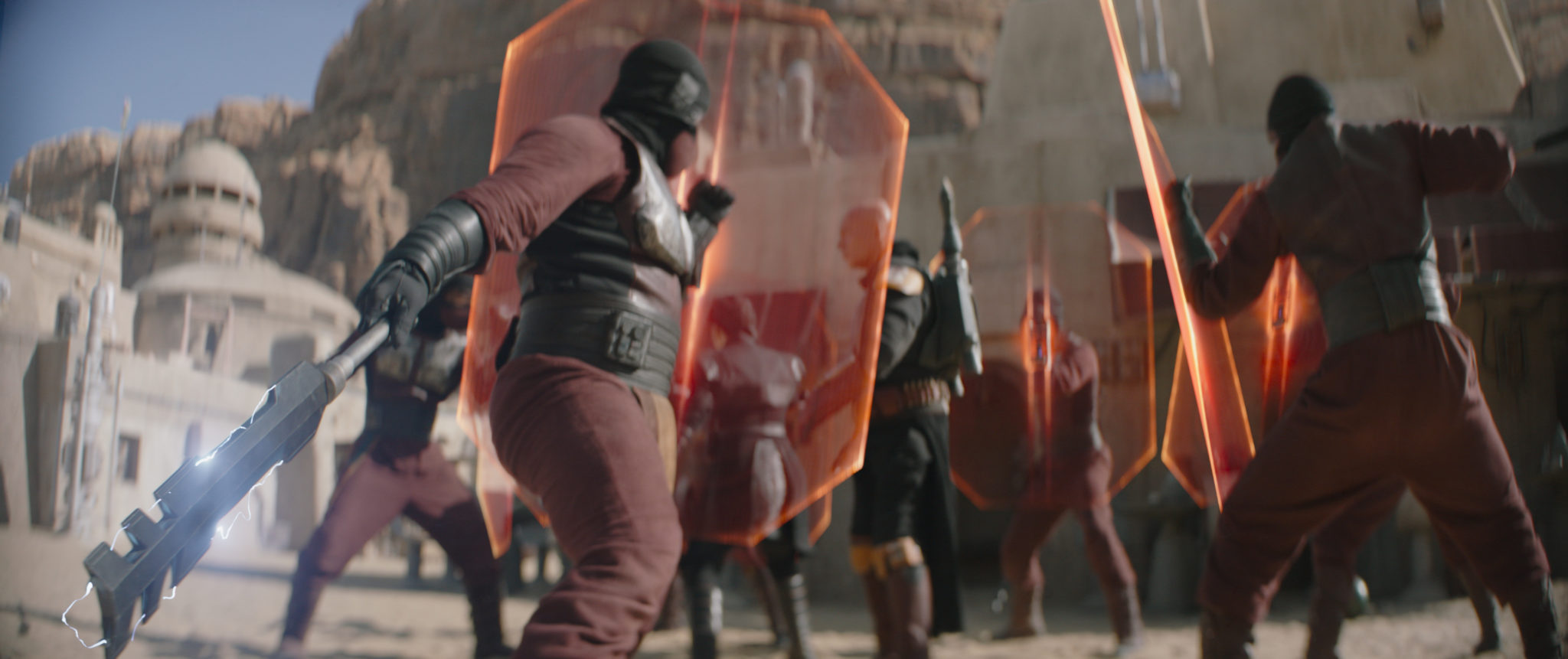
Building Mos Espa
Boba Fett fends off the attacking assassins, bar a handful who escape onto the roofs of Mos Espa. Image Engine helped create much of the ensuing action, including Boba Fett firing a small explosive that leaves a CG crater in a balustrade, and animating a digi-double Fennec Shand, who leaps up the side of the building to pursue the two remaining assassins.
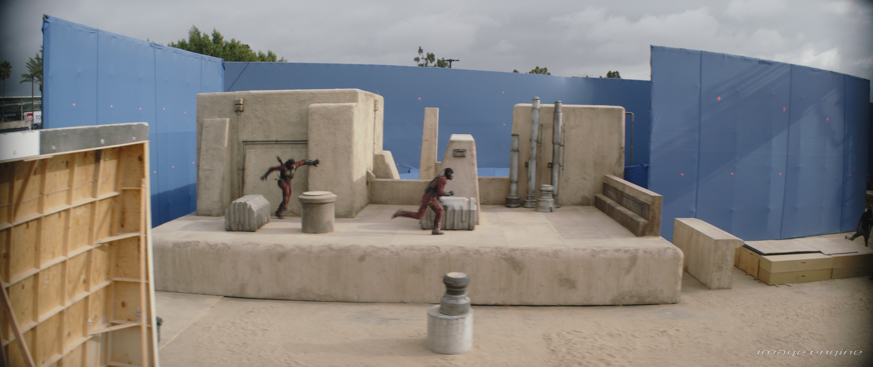
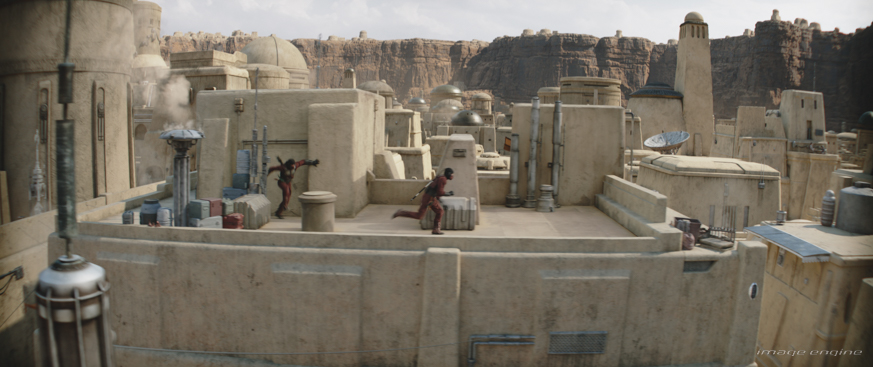
The following chase sequence was filmed against a blue screen set, which Image Engine needed to extend with a digital Mos Espa cityscape. Thankfully, the team already had experience building large Star Wars environments for The Mandalorian. As such, the studio had no problem building Mos Espa’s sandstone rooftops and spires.
“During the assassin attack, the audience saw the street from a low angle, so the set extension work was less substantial,” explains Edmond. “For the chase sequence, the camera raises and reveals Mos Espa stretching out to the wall of the basin in which it sits. We had to create all of the environment, which required a significant number of art-directed buildings to be placed by layout and some procedural techniques to generate things like stucco textures. We based the sand on a huge scan provided by the production and created displacement maps we could procedurally mix across the CG city.
“We put in a lot of work to make sure the buildings were detailed and realistic, and that upfront effort helped throughout the production,” he continues. “We used the CG version of the street to extend many physical sets throughout the show, and even created some specific parts of the city digitally for use in other sequences.”
Death from above
Mos Espa also features a great deal in The Book of Boba Fett’s seventh episode finale: an epic shootout that occurs across almost the entire episode’s runtime and features numerous contributions from the Image Engine team.
The episode opens with Boba Fett and his coterie holed up in the bombed-out husk of the Sanctuary bar, ready to do battle against the Pyke Syndicate. Following failed negotiations, Boba Fett and Din Djarin are compelled to blast out of the Sanctuary and take to the air on jetpacks, where they attack a squadron of Pyke footsoldiers in a rain of laser fire. The duo then lands for a hero shot, shooting back-to-back from the ground, before Din fires off a set of “whistling birds” explosives, which leave curling vapour trails in their destructive wake. Image Engine was responsible for all of the above, as well as extending the set and replacing Din’s Beskar with reflective CG armour.
“As we’d worked with the showrunner before, we knew what they liked and didn’t like. That goes for things like how Mandalorians should look when using their jet packs, which we had animated before on The Mandalorian season one,” explains Cara Davies, VFX Producer.
“Din and Boba’s jetpack movement came in a couple of flavours,” explains Robin. “One technique saw us take plates of the actors moving on wire harnesses and attach digital jetpacks to them. The alternative approach came when the wire performance didn’t look right, in which instance we’d create a digital version of the characters and animate them. Doing so was an interesting challenge, as we had to maintain the feel of practical actors on wires even in our digital animated versions. If we didn’t, the abrupt change in motion would feel bizarre for the audience watching at home!”
The entire sequence featured a variety of work that touched on almost every department on the Image Engine team, as Robin explains. “Matchmove had to ensure the jet packs fully adhered to the bounty hunters’ backs. Animation helped drive things like the characters’ movements as they landed or took off and the flames of the jetpack thrust. Effects had to produce realistic FX for many shots, such as the packs leaving jet streams or kicking up CG dust. Compositing had to layer CG elements with practically shot dust elements. And across all of it, we had to match our digital elements with what was practically shot or what we’re used to seeing in the real world. It was a lot of work—everyone did an amazing job.”
The Scorpenek droids
The Mos Espa battle escalates when the Pyke syndicate introduces two Scorpenek annihilator droids into the fray—quadrupedal battle tanks furnished with enormous rapid-fire laser cannons and spherical, seemingly impenetrable, energy shields. Image Engine ingested the Scorpenek assets from ILM and then animated them across numerous shots.
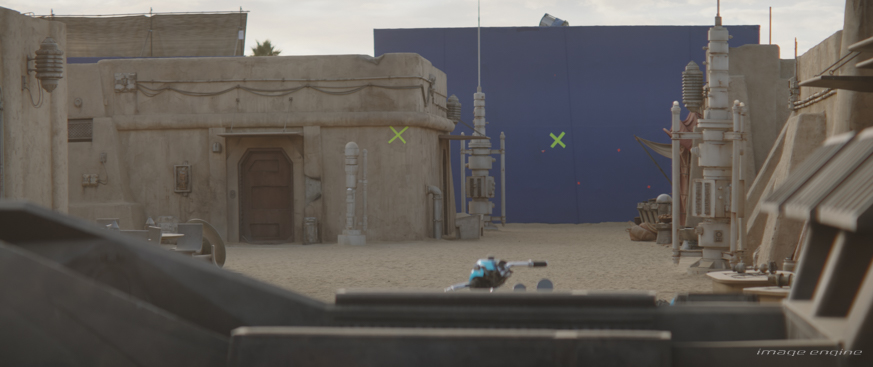
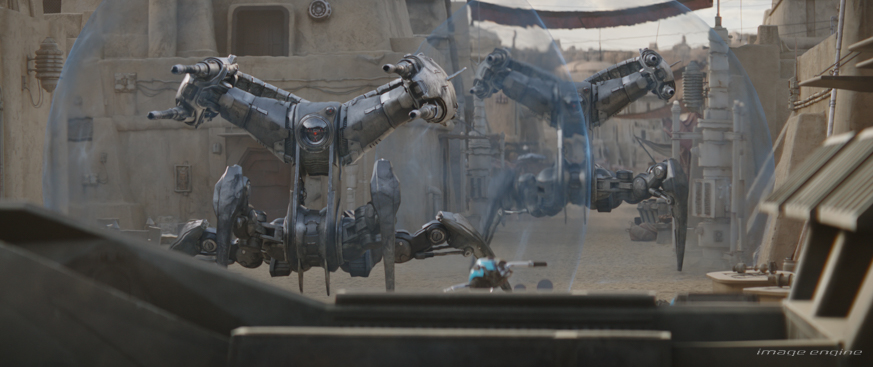
“We take pride in our hard-surface models and how we render and shape them, and the Scorpenek droids were some of our most impressive in the show,” says Robin. “We ingested the assets from the production and made sure they matched the renders and reference imagery supplied. From there, it was all about animating the droids and creating the destruction they cause.”
The Scorpenek droids stalk Din Djarin through the streets of a Mos Espa, indifferent to the laser blasts fired at them, which splatter against their blue shields in harmless displays of fluorescent spray. “Our FX supervisor Alex Lombardi and FX lead Julien Taton created the effect,” says Edmond. “The effect would detect when a blast hits the shield, which would then cause the FX to burst out.”
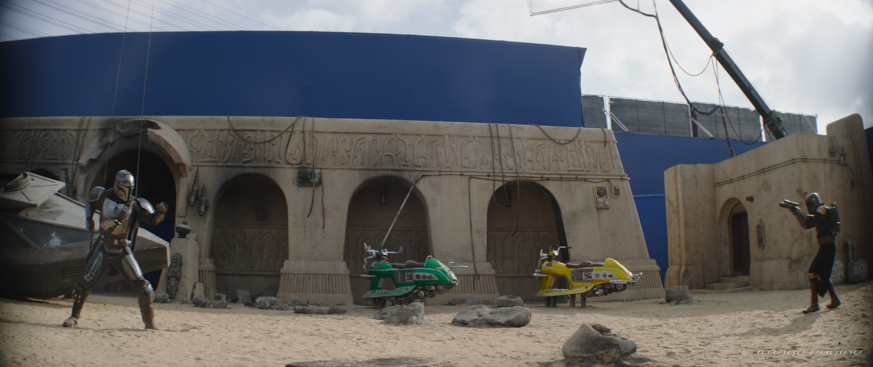
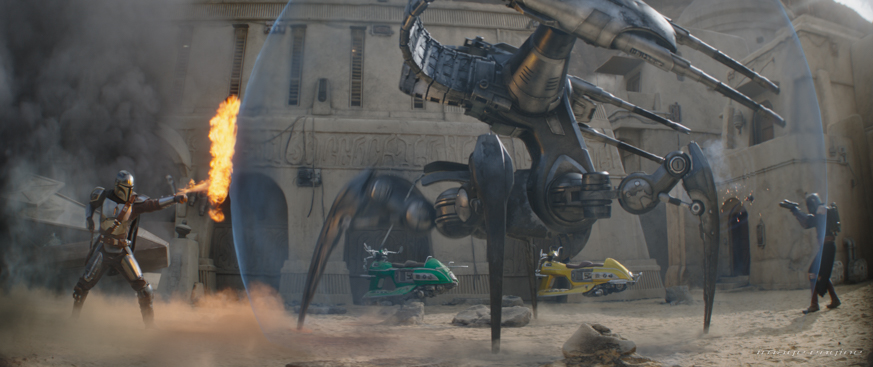
In one shot, Boba Fett fires a missile at the Scorpenek droids, but even it fails to make a mark despite the blossoming ball of yellow and orange flame produced. “We really pushed our realistic explosions capability across the sequence,” says Robin of the effect. “We worked with the production to define what the explosions should look like, showed them quick examples, and once we were aligned, we got going on the full effect and produced it fairly quickly. If I cast my mind back five or six years, CG explosions like these would be extremely difficult to pull off convincingly, especially given our timeline. Today, it’s impressive to see how quickly Image Engine can now go from proof of concept to a believable comp’d explosion. It speaks greatly to the skills of the team.”
Image Engine’s contribution to the sequence ends with Mando jumping onto a rickshaw-droid with Peli Motto, her droids, and Grogu. Image Engine helped integrate these assets and others into the scene, alongside building out the backdrop of Mos Espa architecture.


We are the Mods!
Image Engine’s other significant contribution to the season finale involved The Book of Boba Fett’s cyborg biker gang: the Mods. During the shootout, the Mods race Vespa-like speeder bikes through the streets of Mos Espa to distract the Scorpenek droids; it was up to Image Engine to make the shots feel lifelike.
“On set, the Mods actors were driving on motorcycles, the top half of which were built to look like the speeder bikes,” says Robin. “We had two main things to think about when transforming the motorbikes into speeder bikes. First, we needed to replicate the on-set practical vehicle in CG. Our digital version had to accurately match the look of the practical vehicles so no one would notice when we swapped one out for the other. Secondly, we had to remove the motorbike wheels. To do so, we replaced everything below the bike digitally, which enabled us to create accurate shadows and remove things like the dust kicked up by the practical wheels. We performed this process several times across different Mods bikes.”
In many shots, the Mods and their bikes would overlap one another in a frame, which required reanimating those plates. “We wanted to maintain the plate and the actors as much as possible, as we didn’t have digital stand-ins,” explains Edmond. “So, if one character overlapped another, we had to get clever with how we approached the work and perform a bit of a dance using various techniques to solve the problem. We also had to think about re-timing footage in certain shots and speeding them up. That was a challenge, as we had to make sure shots didn’t have the ‘Benny Hill’ look of everyone moving around too quickly.”
“When an audience watches a sequence like this, they might think they’re straightforward, VFX-wise,” adds Robin. “However, there are always many nuances and considerations. To create the final, immersive shots audiences enjoy, we have to consider many factors to get things looking right. Some of the shots with the Mods highlighted those factors with a magnifying glass. Thankfully, as always, the team was super dedicated and did a great job on making every shot look just perfect.”
This is the way
Indeed, Image Engine’s team was extra dedicated to The Book of Boba Fett, given they were working amid a pandemic and with much of the creative team contributing remotely.
“Being in a pandemic wasn’t ideal, to say the least, but it was the position we were in, and we had to accept it,” says Cara. “Ultimately, tackling the project came down to good planning. We spent a lot of time upfront figuring out methodologies to be as efficient as possible when tackling the volume of work. For example, we identified early on that we had a lot of environment work, so we created a separate environment team just for this project: a small group of artists working closely to flush out 500-600 shots with consistency, despite being physically separated.”
Edmond adds that the tools Image Engine has perfected over the years helped the studio transition to remote work. “Our internal open-source software, Gaffer, and other tools came together and allowed us to create quickly despite the lockdown,” he says. “At this stage, we’re really good at process at Image Engine; everyone’s done this stuff before and knows their job, and the tools are there to handle what we need to do. These things came together on The Book of Boba Fett, even if we were physically apart.”
“Whether it was lighters talking to compers, or effects talking to lighting, we all recognized upfront that constant connection, communication, and collaboration were the keys to success on this project,” concludes Robin. “The team stepped up, and we executed the same high standard of work this studio is known for even when we’re not dealing with a pandemic. I was super proud of the team for both the work they put up on screen and the teamwork they displayed in getting it there.”
“The level of sophistication and shot count keeps heading north with each successive Lucasfilm job we take on,” says executive producer Shawn Walsh. “We’re super proud of how our team rises to the challenge each time. The dedication they show is amazing.”


